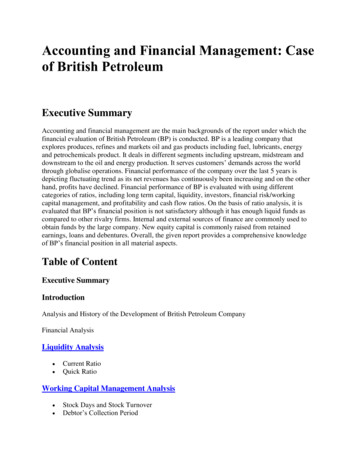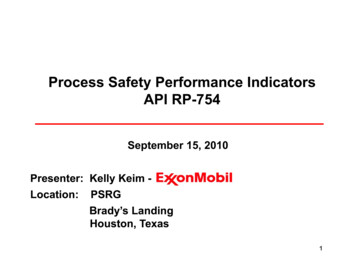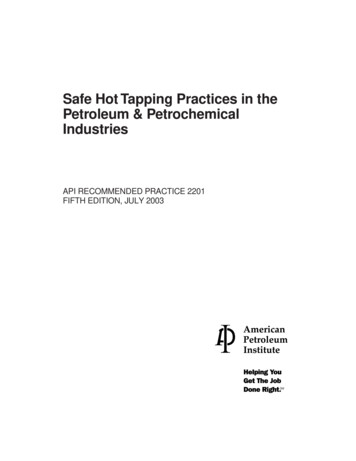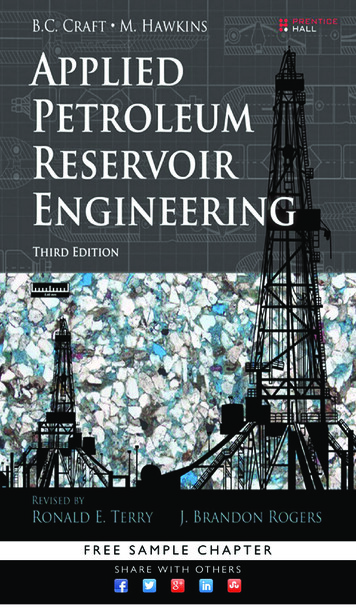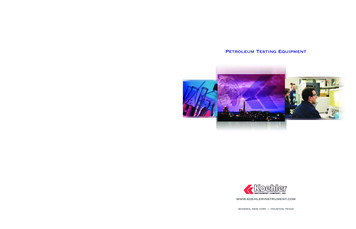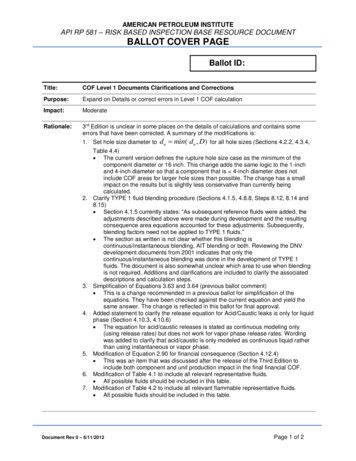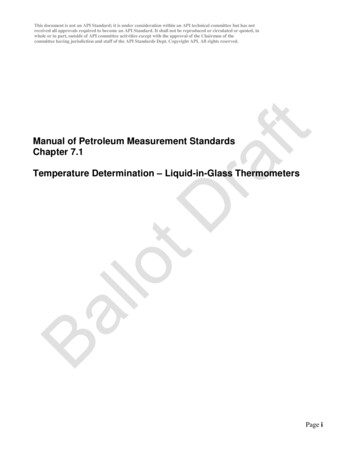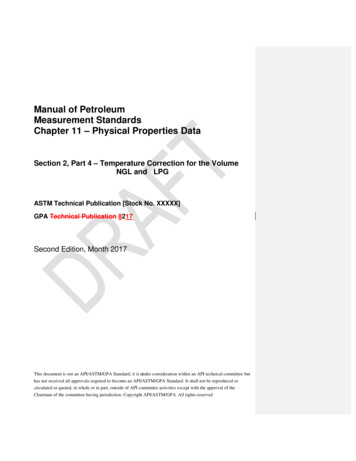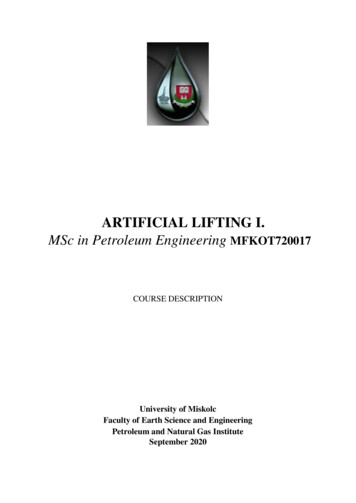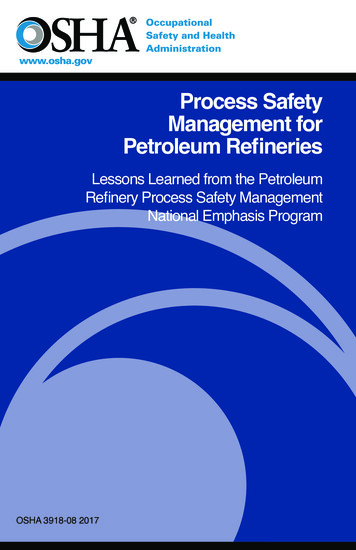
Transcription
Process SafetyManagement forPetroleum RefineriesLessons Learned from the PetroleumRefinery Process Safety ManagementNational Emphasis ProgramOSHA 3918-08 2017
Occupational Safety and Health Act of 1970“To assure safe and healthful working conditions forworking men and women; by authorizing enforcementof the standards developed under the Act; byassisting and encouraging the States in their effortsto assure safe and healthful working conditions; byproviding for research, information, education, andtraining in the field of occupational safety and health.”This report is not a standard or regulation, andit creates no new legal obligations. It containsrecommendations as well as descriptions of mandatorysafety and health standards. The recommendationsare advisory in nature, informational in content, andare intended to assist employers in providing a safeand healthful workplace. The Occupational Safety andHealth Act requires employers to comply with safetyand health standards and regulations promulgatedby OSHA or by a state with an OSHA-approved stateplan. In addition, the Act’s General Duty Clause,Section 5(a)(1), requires employers to provide theiremployees with a workplace free from recognizedhazards likely to cause death or serious physical harm.Material contained in this publication is in the publicdomain and may be reproduced, fully or partially,without permission. Source credit is requested but notrequired.This information will be made available to sensoryimpaired individuals upon request. Voice phone: (202)693-1999; teletypewriter (TTY) number: 1-877-8895627.
Process Safety Management forPetroleum RefineriesLessons Learned from the PetroleumRefinery Process Safety ManagementNational Emphasis ProgramU.S. Department of LaborOccupational Safety and Health AdministrationOSHA 3918-08 2017
ContentsPurpose. . . . . . . . . . . . . . . . . . . . . . . . . . . . . . . . . . . . . . . . . . . . . . . . 3Process Safety Information . . . . . . . . . . . . . . . . . . . . . . . . . . . . . . . . 3Process Hazards Analysis. . . . . . . . . . . . . . . . . . . . . . . . . . . . . . . . . 9Operating Procedures. . . . . . . . . . . . . . . . . . . . . . . . . . . . . . . . . . . . 14Mechanical Integrity. . . . . . . . . . . . . . . . . . . . . . . . . . . . . . . . . . . . . 17Management of Change . . . . . . . . . . . . . . . . . . . . . . . . . . . . . . . . . 25Related Standards . . . . . . . . . . . . . . . . . . . . . . . . . . . . . . . . . . . . . . 28
PurposeThis document highlights areas of the Process Safety Managementstandard (PSM) where OSHA issued the most citations during thePetroleum Refinery Process Safety Management National EmphasisProgram (NEP). These areas include: Process Safety Information (PSI)Process Hazards Analysis (PHA)Operating ProceduresMechanical Integrity (MI)Management of Change (MOC)For more PSM compliance guidance, please refer to OSHA’sProcess Safety Management Guide (OSHA 3132)1 or the full text ofthe standard at www.osha.gov.2Since the PSM standard was promulgated by OSHA in 1992, noother industry sector has had as many fatal or catastrophic incidentsrelated to the release of highly hazardous chemicals (HHC) as thepetroleum refining industry (SIC 2911, NAICS 32411). In responseto this large number of fatal or catastrophic incidents, OSHAinitiated CPL 03-00-004, the Petroleum Refinery Process SafetyManagement National Emphasis Program (NEP), in June 2007.3 Thepurpose of the NEP was to verify refinery employers’ compliancewith PSM. After reviewing the citations issued for violations of thePSM standard under the NEP, OSHA discovered many commoninstances of non-compliance in the petroleum refinery industry.OSHA recommends refineries review these common instances ofnon-compliance to ensure that they do not exist in their own PSMprograms.Process Safety InformationEmployers are required to compile written process safetyinformation (PSI). The compilation of written process safetyinformation enables the employer and the employees involved inoperating the process to identify and understand the hazards posed1. https://www.osha.gov/Publications/osha3132.pdf2. https://www.osha.gov/pls/oshaweb/owadisp.show document?p table STANDARDS&p id 97603. https://www.osha.gov/pls/oshaweb/owadisp.show document?p table DIRECTIVES&p id 3589PROCESS SAFETY MANAGEMENT FOR PETROLEUM REFINERIES3
by those processes involving HHC. Process safety information mustinclude information pertaining to the hazards of the HHC used orproduced by the process, information pertaining to the technologyof the process, and information pertaining to the equipment in theprocess. Complete and accurate compilation of PSI is critical to theeffective implementation of all other aspects of the PSM.PSI provisions of the standard also require that all equipment inPSM-covered processes comply with recognized and generallyaccepted good engineering practices (RAGAGEP). The PSMstandard allows employers to select the RAGAGEP they apply intheir covered processes. Examples of RAGAGEP include widelyadopted codes, consensus documents, non-consensus documents,and internal standards.4 Furthermore, where the design codes,standards, or practices used in the design and construction ofexisting equipment are no longer in general use, the employermust determine and document that the equipment is designed,maintained, inspected, tested, and operating in a safe manner.5Regarding the PSI element, during inspections under the NEPOSHA issued many citations for violations of the PSM standardrelated to the (1) RAGAGEP, (2) piping & instrumentation diagrams(P&IDs), and (3) relief system design basis.1. PSI RAGAGEPA. Relief Systems RAGAGEPDuring NEP inspections, OSHA found instances where employers’written PSI did not contain information about: Missing relief devices,Undersized safety relief valves,Incorrect relief valve set points,High back pressure on relief valves, andRelief devices in an inaccessible location (for further information,see the Human Factors section).4. https://www.osha.gov/pls/oshaweb/owadisp.show document?p table INTERPRETATIONS&p id 307855. 29 CFR 1910.119(d)(3)(iii)OCCUPATIONAL SAFETY AND HEALTH ADMINISTRATION4
API 520: Sizing, Selection, and Installation of Pressure-RelievingDevices in Refineries is an example of a RAGAGEP often used inpetroleum refineries. API 520 covers appropriate relief system sizecalculations based on process parameters such as flow rate andpressure. API 520 also provides information on how to maintainappropriate back pressure on relief valves. According to API 520, asymptom of relief valves with excessive back pressure is flutteringor chattering of the valve. Chattering may affect the integrity of therelief device and interconnected piping, as well as reduce reliefcapacity.During NEP inspections, OSHA also found deficiencies in thepositioning of intervening6 valves. According to the AmericanSociety of Mechanical Engineers (ASME) Boiler and PressureVessel Code, Section VIII (Code), an example RAGAGEP, “Thereshall be no intervening stop valves between the vessel and itspressure relief device or devices, or between the pressure reliefdevice or devices and the point of discharge, except: (1) whenthese stop valves are so constructed or positively controlled thatthe closing of the maximum number of block valves possible atone time will not reduce the pressure relieving capacity providedby the unaffected pressure relief devices below the requiredrelieving capacity; or (2) under conditions set forth in AppendixM.”7 If intervening valves are closed in the event of an uncontrolledpressure increase, then the designed relief path will be blocked. Asa result, pressure can rise instantly which can rupture pipes andvessels. The consequences can include facility damage, injury, anddeath. Appropriate, engineering and administrative controls shouldbe utilized and kept up to date in order to prevent such unsafeconditions.8 Appendix M of the Code provides information on how tocontrol processes that include intervening (“stop”) valves located inthe relief path.Additionally, the Chemical Center for Process Safety (CCPS)recommends reviewing completed lockout permits to identifyconditions that do not appear to be appropriate (such as an6. In this case, “intervening” valves are any valves that are positioned between a piece of pressurizedequipment and a relief device’s discharge location,, such that if these valves were to be closed they wouldprevent the relief system from safely relieving any overpressure. Intervening valves are sometimes locatedupstream and downstream of a relief device.7. ASME Boiler and Pressure Vessel Code, Division 1, Section VIII, UG-135(d)8. Ibid.PROCESS SAFETY MANAGEMENT FOR PETROLEUM REFINERIES5
intervening valve remaining closed, or not verified re-opened), oridentifying persons authorizing permits or doing work who do noteffectively understand how to authorize or conduct nonroutinework9.B. Facility Siting RAGAGEPDuring NEP inspections, OSHA found many instances where petroleumrefineries did not document facility siting RAGAGEP to control toxicand/or fire and explosion hazards in buildings and structures housingemployees.OSHA found several instances where refineries did not comply withRAGAGEP, including but not limited to API RP-752: Managementof Hazards Associated with Location of Process Plant PermanentBuildings, and API RP-753: Management of Hazards Associatedwith Location of Process Plant Portable Buildings. Specifically, somepetroleum refineries could not document that the locations of controlrooms, portable buildings, and other areas frequented by employeeswere adequately protected from fire, explosion, or toxic release. Inmany cases separating these structures away from the coveredprocess will be protective; however, in some cases a fixed structuremay need more protection, such as positive pressure ventilation,structural reinforcement, or intervening blast walls.10 Employers canalso restrict access of non-essential employees to prevent unnecessaryexposure to the hazards of the covered process.API RP-752, an example of a RAGAGEP for safe building siting,suggests that petroleum refineries should:a) Select a credible release scenario11 which refiners should notchange unless the employer can reasonably demonstrate that theoriginal scenario was unrealistic;b) Model the release and consequences;9. CCPS, Guidelines for Risk Based Process Safety. (2007). Hoboken, NJ: Wiley-Interscience.10. API RP-752: Management of Hazards Associated With Location of Process Plant Permanent Buildings(2009)11. Ibid.: defines a “maximum credible event” as, “A hypothetical explosion, fire, or toxic material releaseevent that has the potential maximum consequence to the occupants of the building under consideration fromamong the major scenarios evaluated. The major scenarios are realistic and have a reasonable probability ofoccurrence considering the chemicals, inventories, equipment and piping design, operating conditions, fuelreactivity, process unit geometry, industry incident history, and other factors.”OCCUPATIONAL SAFETY AND HEALTH ADMINISTRATION6
c) Locate personnel away from process areas consistent with safe andeffective operations;d) Minimize the use of buildings intended for occupancy in closeproximity to process areas;e) Restrict the occupancy of buildings in close proximity to processareas;f) Design, construct, install, modify, and maintain buildings intendedfor occupancy to protect occupants against explosion, fire, and toxicmaterial releases; andg) Manage the use of buildings intended for occupancy as an integralpart of the design, construction, maintenance, and operation of afacility.2. Piping and Instrumentation DiagramsThe PSM standard requires employers to maintain piping andinstrumentation diagrams (P&IDs). P&IDs show the interconnectionof process equipment, the instrumentation used to control theprocess, and they provide engineers, operators, and maintenanceemployees with information on how to maintain and modify theprocess. P&IDs must accurately demonstrate the physical sequenceof equipment and systems, and how these systems are connected.12Without accurate, complete, and up-to-date P&IDs, engineers andoperators can be misinformed: During the PHA process,When creating or modifying operating, maintenance, and repairprocedures,When generating work permits,During new equipment installation, andWhen troubleshooting or maintaining a process.During NEP inspections, OSHA found that many petroleum refineriesfailed to maintain accurate, complete, and up-to-date P&IDs for theequipment in the process.PSM is a performance-based standard and not all P&IDs containthe same information. Employers should be sure that employees12. 29 CFR 1910.119(d)(3)(i)(B)PROCESS SAFETY MANAGEMENT FOR PETROLEUM REFINERIES7
understand what to expect on their P&IDs based on the refinery’sPSM program. An example of an industry practice for the format andcontent of P&IDs is the Process Industry Practices, PIC 001, Pipingand Instrumentation Diagram Documentation Criteria (April 2008).During NEP inspections, OSHA cited several instances wherepetroleum refineries did not check to ensure that tags on theirequipment matched what was written in the P&ID, or that allP&IDs at a facility shared the same notation system. Such errorsand inconsistencies may lead to confusion or an incident whenmaintaining or repairing process equipment. An example of anindustry practice notation system that employers can use is theInstrumentation, Systems, and Automation Society’s (ISA) ANSI/ISA-S5.1 Instrumentation Symbols and Identification AmericanNational Standard.When OSHA found P&ID deficiencies, such as those identifiedabove, the problems were frequently systemic and encompassedmany of these deficiencies. Failure to ensure the accuracy of facilityP&IDs may also indicate problems with the employer’s Managementof Change program.3. Relief
API RP-752, an example of a RAGAGEP for safe building siting, suggests that petroleum refineries should: a) Select a credible release scenario11 which refiners should not change unless the employer can reasonably demonstrate that the original scenario was unrealistic; b) Model the release and consequences; 9.

